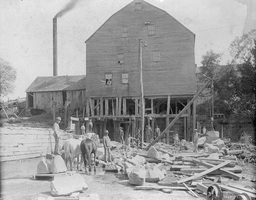 | Back to e-WV
| Back to e-WV
 The West Virginia Encyclopedia
The West Virginia Encyclopedia
 | Back to e-WV
| Back to e-WV
 The West Virginia Encyclopedia
The West Virginia Encyclopedia

The Kanawha Valley salt industry over-expanded during the boom years surrounding the War of 1812. As a result, salt prices fell below manufacturing and distribution costs, causing salt companies to fail.
Dominant producers, including Andrew Donnally and the four Steele brothers, reacted to the overproduction and cutthroat competition by buying up distressed competitors, but ultimately they lacked the capital to control more than half of Kanawha Valley salt production. Unable to monopolize production, they sought another form of combination to satisfy other manufacturers by sharing profit and risk through output restrictions and centralized marketing. On November 10, 1817, Donnally and the Steeles with 16 other producers created the Kanawha Salt Company to control production and marketing for all involved. The idea was to raise prices by limiting production. The agreement limited total salt production to a maximum of 450,000 bushels and set production quotas for participating producers. The company could purchase or lease other salt furnaces to control their production. Dividends were paid according to participating producers’ share of the total output.
The Kanawha Salt Company began operation on January 1, 1818, and was to continue until December 31, 1822. But the company never included all manufacturers as at least five never entered the agreement. This first attempt by a majority of Kanawha manufacturers to combine for common ends did not survive the year as the devastating Panic of 1819 crushed all western commerce.
The Kanawha Salt Company is sometimes mistakenly said to have been the first ‘‘trust’’ in the United States. Actually, the company was an output pool and central sales agency. It is the earliest known output pool in the United States. This abortive agreement served as the precursor of six different antebellum salt arrangements to control salt production and marketing. What Kanawha salt makers attempted became common business practice in the post-Civil War United States as arrangements for concert and combination spread to other industries.
Written by John Edmund Stealey III
Stealey, John E. III. The Antebellum Kanawha Salt Business and Western Markets. Lexington: University Press of Kentucky, 1993.
Stealey, John E. III, ed. Kanawhan Prelude to Nineteenth-Century Monopoly in the United States: The Virginia Salt Combinations. Richmond: Virginia Historical Society, 2000.